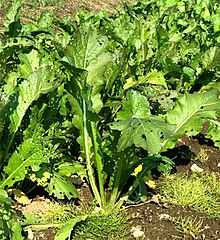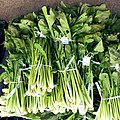Nozawana
| Nozawana | |
|---|---|

| |
| Nozawana | |
| Scientific classification | |
| Kingdom: | |
| (unranked): | |
| (unranked): | |
| (unranked): | |
| Order: | |
| Family: | |
| Genus: | |
| Species: | B. rapa (syn B. campestris)
|
| Variety: | B. r. var. hakabura
|
| Trinomial name | |
| Brassica rapa L. var. hakabura | |
Nozawana (野沢菜), Brassica rapa L. var. hakabura) is a Japanese leaf vegetable, of the brassica family, a form of turnip greens. It is a biennial plant often pickled. that has been cultivated in the Shin'etsu region, centered around the village of Nozawaonsen, Shimotakai District, Nagano Prefecture. It is of the same species as the common turnip and one of a Japanese variety of mustard leaf.
Also known as Shinshuuna (信州菜), it is counted as one of Japan's three major pickled vegetables, along with Takana and Hiroshimana. After World War II, it began to be grown nationwide, from Hokkaido to Kumamoto. Its leaves are approximately 60–90 centimetres (24–35 in) long. If left to overwinter without harvesting, the rapeseed will sprout and yellow rapeseed flowers will bloom in the spring.
Background[edit]
Nozawana is part of the turnip family. Currently, it is thought to be a different variety derived from the turnip (var. hakabura: Turnip greens), and is currently being used as a traditional pickled vegetable grown in the area (inekokina, haburona, narusawana, chōzenna).[1] Both turnips and purple turnips (Suwa beni turnip, Hososhima turnip, etc.) are thought to be closely related.[2]
Tradition holds that sometime between 1751 and 1764 the plant was brought from the Kyoto mountains to the Nozawaonsen village by the master of a Buddhist Kenmeiji Temple who lived in Nozawa. It has been cultivated around that area ever since, and thus is now called "Nozawana" (na means vegetable in Japanese).[3] Also known as Shinshuuna (信州菜), Nozawana is one of Japan's three major pickled vegetables, along with Takana and Hiroshimana.[4]
Turnips in Japan are broadly divided into the Asian variety (i.e. bomdong) via China, which is prevalent in western Japan, and the European variety (brassica rapa) via Siberia, common in the mountainous areas of eastern Japan and has excellent cold resistance.[5] Nozawana is not Asian like daikon, but has strong European characteristics, and closely related species have been found in Fukushima Prefecture.
Pickled nozawana is among the most typical local foods in Nagano Prefecture. It is also used in onigiri.[6] Before the Taishō era (1912-1926), local villagers called the plant a turnip (turnip), but visiting skiers from the city who visited a local ski resort were so impressed by the pickled turnip that they nicknamed it "Nozawanazuke". From then on became known as Nozawana and Nozawana pickled throughout the country. After World War II, it began to be grown nationwide, from Hokkaido to Kumamoto.[4]
Its leaves are approximately 60–90 centimetres (24–35 in) long. If left to overwinter without harvesting, the rapeseed will sprout and yellow rapeseed flowers will bloom in the spring.[2]
Cultivation[edit]
For cultivation, seeds are sown in September and thinned out repeatedly, with the thinned seedlings eaten as pickled vegetables. Buds will grow from the remaining roots after the snow thaws the following spring. These flowers can be harvested and used as vegetables (totachina), or as new seeds that can be sown to grow spring mustard and Japanese warbler. The leafy above-ground part grows further and blooms in May, and its seeds are collected in June. The leaves are harvested from October through December and used primarily for pickled Nozawana.[1]
At Nozawa Onsen, Nozawana has been cultivated as a successor crop on arable land known as "Obatake", where hemp was cultivated until the Meiji period. The original seed of Nozawana called "teradane" is grown in the field of the residence of Kenmeiji Temple in Nozawa Onsen, and is sold as "turnip seed".[7]
In the areas where Nozawa Onsen's hot spring bathers went and the areas where Nozawana was cultivated are almost the same, as visitors to Nozawa Onsen bought turnip seeds as souvenirs.[1]
The lyrics for "Oborozukiyo", which begins with "Enter the rape field and the sun fades," were written by Tatsuyuki Takano, who was born in Nagae Village, Nagano Prefecture (now Oaza Nagae, Nakano City). In the Hokushin region of Nagano Prefecture, rapeseed has been cultivated as a major cash crop since the Edo period, and it is assumed that the motif of the lyrics was the memory of rapeseed rape blossoms spreading all over the place.[1]
When the demand for rapeseed oil decreased and rapeseed cultivation ceased, rape blossoms disappeared, but in recent years the Nozawana flowers grown for tourism have become popular. In Europe there is a vegetable called turnip tops, and in Italy it is called cima di rapa. Although it is not classified as a turnip, it is similar to Nozawana in that its roots enlarge like a turnip, but are not edible.[7]
Pickling[edit]

When harvested, the turnip greens are separated from the roots (the turnips).[8] The greens are washed in a communal bath (i.e. onsen), and then soaked in a large wooden bucket. In its preparation, each family has their own seasonings.[7]
There are honzuke (pickled shallots), which have undergone lactic acid fermentation and has turned amber color, and with a light pickle, remains green.[9]
Because it is manufactured and stored in a cold environment, fermentation does not progress very far, and it is characterized by a light taste and low odor. If left at room temperature, it will rapidly soften, change its texture, and increase its sour taste, so it must be kept at a low temperature for storage. It is widely loved as an accompaniment to tea and drinks. In addition to eating it as is, it has a wide range of uses, such as being used in stir-fried dishes and fried rice, or chopped into small pieces and mixed with nattō as a condiment. It is also popular as an ingredient in rice balls and oyaki. Those with a strong sour taste are sometimes stir-fried with soy sauce, sugar, and oil and eaten as "tsukudani style".[7]
In the Hokushin region of Nagano Prefecture, Nozawana is called "Ona" or "Nappa", and Nozawana pickled vegetables are called "Ohazuke".[9]
In Nagano Prefecture, the production area, there was a problem in supplying green pickled vegetables all year round. Mainly produced in Shizuoka Prefecture, from March to May, tunnel-grown products are mainly produced in Yamanashi and Nagano prefectures, in June, mainly produced in Ibaraki prefecture, and from July to September, mainly produced in Yatsugatake in Nagano prefecture. The solution was to move the production area from the middle of the mountain to Togakushi .[10]
In 1983, Nagano Prefecture selected Nozawana pickles as a "Nagano Prefecture Selected Intangible Folk Cultural Property, Cultural Property of Shinano Taste."[9]
Gallery[edit]
-
Mentaiko and nozawana on rice
-
Nozawana sold in bundles.
Further reading[edit]
- 日本食品標準成分表2015年版(七訂) [Japanese Food Standard Ingredients List] (7 ed.). Ministry of Education, Culture, Sports, Science and Technology. 2015.
See also[edit]
References[edit]
- ^ a b c d "Nozawana - the perfect pickle in Nozawa Onsen". Nozawa Holidays. August 16, 2016. Retrieved June 25, 2019.
- ^ a b "Pickled Mustard Leaves (Nozawana-zuke)". Asian Inspirations. July 17, 2017. Retrieved June 25, 2019.
- ^ Aoba, Taka (1964), 本邦そ菜在来品種の地理的分布と分類に関する研究 [Study on the geographical distribution and classification of native varieties of Japanese soybean], Journal of the Horticultural Society of Japan (in Japanese), vol. 4
- ^ a b "野沢菜物語" [Nozawana story]. Nozawa Onsen Mountain Resort Tourism Bureau (in Japanese). Retrieved May 13, 2020.
- ^ Shibuya, Shigeru; Okamura, Tomomasa (1952), 種子の表皮型に依る本邦蕪菁品種の分類 [Classification of Japanese Buccane varieties according to the epidermis type of seeds], Journal of the Horticultural Society of Japan, vol. 4
- ^ "Japanese Savoury Buns (Nozawana Oyaki)". Asian Inspirations. July 17, 2017. Retrieved June 25, 2019.
- ^ a b c d Uehara, Kazuo. "Nozawana - the village pickle". nozawahospitality.com.
- ^ "Harvesting Turnips and Turnip Greens". Gardening With Tracy. 2020 – via YouTube.
- ^ a b c 信濃の食文化 [Shinano Food Culture] (in Japanese). Kyoritsu Planning. April 1, 1986. p. 4.
- ^ "漬物の製造法" [Pickle manufacturing method] (PDF) (in Japanese). tsukemono-japan.org. Retrieved April 8, 2022.
External links[edit]
- Oi, Michio; Sato, Yasuko (2002). 長野県在来カブ・ツケナ品種の類縁関係 [Relationships of turnip and tsukena varieties native to Nagano Prefecture]. Horticultural Research (in Japanese). Vol. 1. p. 237-240. doi:10.2503/hrj.1.237.


